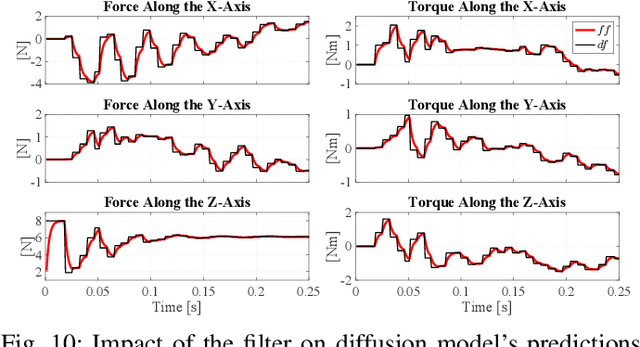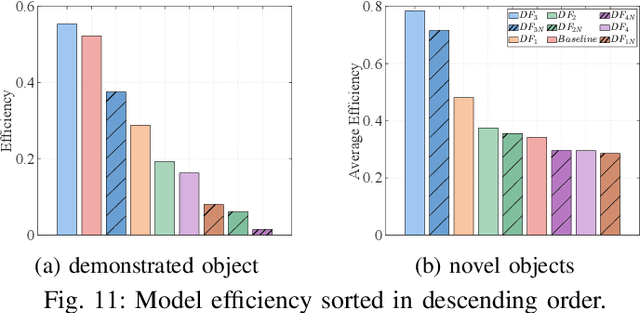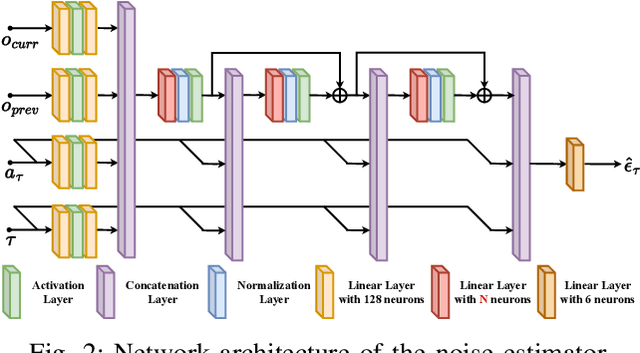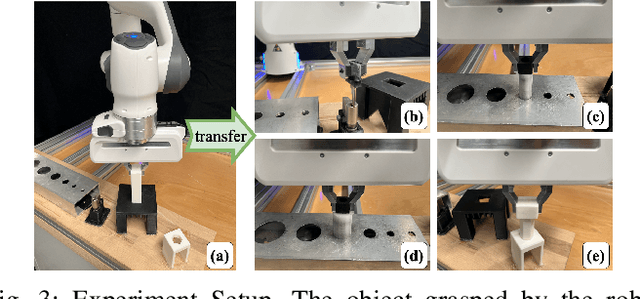Liding Zhang
Pretrained Bayesian Non-parametric Knowledge Prior in Robotic Long-Horizon Reinforcement Learning
Mar 27, 2025Abstract:Reinforcement learning (RL) methods typically learn new tasks from scratch, often disregarding prior knowledge that could accelerate the learning process. While some methods incorporate previously learned skills, they usually rely on a fixed structure, such as a single Gaussian distribution, to define skill priors. This rigid assumption can restrict the diversity and flexibility of skills, particularly in complex, long-horizon tasks. In this work, we introduce a method that models potential primitive skill motions as having non-parametric properties with an unknown number of underlying features. We utilize a Bayesian non-parametric model, specifically Dirichlet Process Mixtures, enhanced with birth and merge heuristics, to pre-train a skill prior that effectively captures the diverse nature of skills. Additionally, the learned skills are explicitly trackable within the prior space, enhancing interpretability and control. By integrating this flexible skill prior into an RL framework, our approach surpasses existing methods in long-horizon manipulation tasks, enabling more efficient skill transfer and task success in complex environments. Our findings show that a richer, non-parametric representation of skill priors significantly improves both the learning and execution of challenging robotic tasks. All data, code, and videos are available at https://ghiara.github.io/HELIOS/.
Motion Planning for Robotics: A Review for Sampling-based Planners
Oct 28, 2024Abstract:Recent advancements in robotics have transformed industries such as manufacturing, logistics, surgery, and planetary exploration. A key challenge is developing efficient motion planning algorithms that allow robots to navigate complex environments while avoiding collisions and optimizing metrics like path length, sweep area, execution time, and energy consumption. Among the available algorithms, sampling-based methods have gained the most traction in both research and industry due to their ability to handle complex environments, explore free space, and offer probabilistic completeness along with other formal guarantees. Despite their widespread application, significant challenges still remain. To advance future planning algorithms, it is essential to review the current state-of-the-art solutions and their limitations. In this context, this work aims to shed light on these challenges and assess the development and applicability of sampling-based methods. Furthermore, we aim to provide an in-depth analysis of the design and evaluation of ten of the most popular planners across various scenarios. Our findings highlight the strides made in sampling-based methods while underscoring persistent challenges. This work offers an overview of the important ongoing research in robotic motion planning.
TacDiffusion: Force-domain Diffusion Policy for Precise Tactile Manipulation
Sep 17, 2024



Abstract:Assembly is a crucial skill for robots in both modern manufacturing and service robotics. However, mastering transferable insertion skills that can handle a variety of high-precision assembly tasks remains a significant challenge. This paper presents a novel framework that utilizes diffusion models to generate 6D wrench for high-precision tactile robotic insertion tasks. It learns from demonstrations performed on a single task and achieves a zero-shot transfer success rate of 95.7% across various novel high-precision tasks. Our method effectively inherits the self-adaptability demonstrated by our previous work. In this framework, we address the frequency misalignment between the diffusion policy and the real-time control loop with a dynamic system-based filter, significantly improving the task success rate by 9.15%. Furthermore, we provide a practical guideline regarding the trade-off between diffusion models' inference ability and speed.
Online Efficient Safety-Critical Control for Mobile Robots in Unknown Dynamic Multi-Obstacle Environments
Feb 26, 2024Abstract:This paper proposes a LiDAR-based goal-seeking and exploration framework, addressing the efficiency of online obstacle avoidance in unstructured environments populated with static and moving obstacles. This framework addresses two significant challenges associated with traditional dynamic control barrier functions (D-CBFs): their online construction and the diminished real-time performance caused by utilizing multiple D-CBFs. To tackle the first challenge, the framework's perception component begins with clustering point clouds via the DBSCAN algorithm, followed by encapsulating these clusters with the minimum bounding ellipses (MBEs) algorithm to create elliptical representations. By comparing the current state of MBEs with those stored from previous moments, the differentiation between static and dynamic obstacles is realized, and the Kalman filter is utilized to predict the movements of the latter. Such analysis facilitates the D-CBF's online construction for each MBE. To tackle the second challenge, we introduce buffer zones, generating Type-II D-CBFs online for each identified obstacle. Utilizing these buffer zones as activation areas substantially reduces the number of D-CBFs that need to be activated. Upon entering these buffer zones, the system prioritizes safety, autonomously navigating safe paths, and hence referred to as the exploration mode. Exiting these buffer zones triggers the system's transition to goal-seeking mode. We demonstrate that the system's states under this framework achieve safety and asymptotic stabilization. Experimental results in simulated and real-world environments have validated our framework's capability, allowing a LiDAR-equipped mobile robot to efficiently and safely reach the desired location within dynamic environments containing multiple obstacles.
Real-time Contact State Estimation in Shape Control of Deformable Linear Objects under Small Environmental Constraints
Jan 30, 2024Abstract:Controlling the shape of deformable linear objects using robots and constraints provided by environmental fixtures has diverse industrial applications. In order to establish robust contacts with these fixtures, accurate estimation of the contact state is essential for preventing and rectifying potential anomalies. However, this task is challenging due to the small sizes of fixtures, the requirement for real-time performances, and the infinite degrees of freedom of the deformable linear objects. In this paper, we propose a real-time approach for estimating both contact establishment and subsequent changes by leveraging the dependency between the applied and detected contact force on the deformable linear objects. We seamlessly integrate this method into the robot control loop and achieve an adaptive shape control framework which avoids, detects and corrects anomalies automatically. Real-world experiments validate the robustness and effectiveness of our contact estimation approach across various scenarios, significantly increasing the success rate of shape control processes.
Flexible Informed Trees (FIT*): Adaptive Batch-Size Approach for Informed Sampling-Based Planner
Oct 19, 2023



Abstract:In modern approaches to path planning and robot motion planning, anytime almost-surely asymptotically optimal planners dominate the benchmark of sample-based planners. A notable example is Batch Informed Trees (BIT*), where planners iteratively determine paths to groups of vertices within the exploration area. However, maintaining a consistent batch size is crucial for initial pathfinding and optimal performance, relying on effective task allocation. This paper introduces Flexible Informed Tree (FIT*), a novel planner integrating an adaptive batch-size method to enhance task scheduling in various environments. FIT* employs a flexible approach in adjusting batch sizes dynamically based on the inherent complexity of the planning domain and the current n-dimensional hyperellipsoid of the system. By constantly optimizing batch sizes, FIT* achieves improved computational efficiency and scalability while maintaining solution quality. This adaptive batch-size method significantly enhances the planner's ability to handle diverse and evolving problem domains. FIT* outperforms existing single-query, sampling-based planners on the tested problems in R^2 to R^8, and was demonstrated in real-world environments with KI-Fabrik/DARKO-Project Europe.
 Add to Chrome
Add to Chrome Add to Firefox
Add to Firefox Add to Edge
Add to Edge